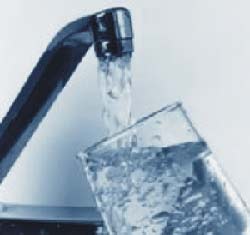For nearly a month now, thousands of households using tap water in Son Tra District (Da Nang City) have been consuming water contaminated with coliform bacteria. The health sector has repeatedly warned the water supply unit, but the situation has not improved.
Heavy Rain Means Cloudy Water
 Mr. Mai Thanh Thuc (Ngo Quyen Street) describes: the tap water often has tiny sediments, with a cloudy color instead of being clear. This issue has persisted for quite some time. Therefore, in the mornings, residents usually have to discard the first 1-2 buckets of water to eliminate the sediment in the pipes before using it. To be even more cautious, many families have to filter the water through sedimentation tanks before using it.
Mr. Mai Thanh Thuc (Ngo Quyen Street) describes: the tap water often has tiny sediments, with a cloudy color instead of being clear. This issue has persisted for quite some time. Therefore, in the mornings, residents usually have to discard the first 1-2 buckets of water to eliminate the sediment in the pipes before using it. To be even more cautious, many families have to filter the water through sedimentation tanks before using it.
“Whenever it rains heavily on Son Tra Mountain, we have to drink cloudy water” – a resident in Man Thai Ward reported. This is why many families in Son Tra, despite having access to tap water, still hire drillers to install wells.
“Some days the water is very clear, with no chlorine smell, but on other days, it has a strong chlorine odor. Even though it’s supplied by the water plant, it still makes us uneasy!” – Mr. Vo Nhu Thang, Vice Chairman of the People’s Council of Tho Quang Ward, Son Tra District, stated.
According to Mr. Thang, out of 22,000 residents in the ward, over 40% of those using tap water frequently report that their water has sediment. The water source is taken from the Suoi Da system on Son Tra Mountain, but recently, due to an influx of tourists, the water source has been somewhat affected.
Testing Water with the Naked Eye!
|
High chlorine levels in water can cause abnormal disturbances in the digestive system and intestines of users. Low chlorine levels fail to eliminate all bacteria, rendering the water source unsafe. If the water is contaminated with coliform, the risk of gastrointestinal poisoning is very high, especially during the hot season. (Source: Da Nang Center for Disease Control) |
With three pumping stations with a capacity of 5,000-10,000 m3/day, the Son Tra Water Plant is responsible for supplying clean water to the residents of Tho Quang, Man Thai, and Nai Hien Dong wards.
Mr. Nguyen Van Hoang – team leader of the Son Tra Water Plant – stated: “The plant checks the chlorine concentration in the water daily by comparing treated water samples with standard color tubes.” When we asked how they conduct these tests, Mr. Hoang innocently replied: “Well, we test it with… the naked eye.”
According to the test results from the Da Nang Center for Disease Control in several areas of Son Tra District in June, the tap water from Son Tra does not meet microbiological standards (coliform contamination).
On July 1, the health sector continued to collect water samples in An Hai Bac Ward (Son Tra District) and found very high levels of coliform in the water: 150 bacteria per 100ml of water. Previously, in May, the residual chlorine levels were excessively high, making it impossible for health officials to determine the alkalinity. In contrast, during June, the residual chlorine in the water was almost nonexistent.
The health sector issued an urgent notice to the water supply unit, emphasizing that the water quality from the plant had not met permissible standards in recent months, yet no improvements have been made. They urged the water supply unit to promptly review the water treatment process and the water distribution system to ensure the health safety of the population.
Mr. Bui Tho Ninh – head of the technical and planning department of Da Nang Water Supply Company – acknowledged that the cloudy water and unstable chlorine levels in the Son Tra water source do exist, due to the outdated water supply system. To prevent cloudy water issues, the water supply unit will cut off the Son Tra water supply whenever it rains.
The company has invested in equipment to pump chlorine using an electrolytic machine, ensuring that the chlorine levels in the water remain stable within acceptable limits. However, the water supply company has yet to answer the question: why is the water source contaminated with coliform bacteria?
D.NAM – V.HUNG


















































